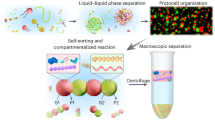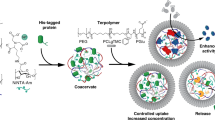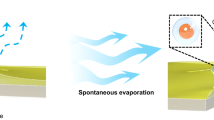Abstract
Recent progress in the chemical construction of colloidal objects comprising integrated biomimetic functions is paving the way towards rudimentary forms of artificial cell-like entities (protocells). Although several new types of protocells are currently available, the design of synthetic protocell communities and investigation of their collective behaviour has received little attention. Here we demonstrate an artificial form of predatory behaviour in a community of protease-containing coacervate microdroplets and protein–polymer microcapsules (proteinosomes) that interact via electrostatic binding. The coacervate microdroplets act as killer protocells for the obliteration of the target proteinosome population by protease-induced lysis of the protein–polymer membrane. As a consequence, the proteinosome payload (dextran, single-stranded DNA, platinum nanoparticles) is trafficked into the attached coacervate microdroplets, which are then released as functionally modified killer protocells capable of rekilling. Our results highlight opportunities for the development of interacting artificial protocell communities, and provide a strategy for inducing collective behaviour in soft matter microcompartmentalized systems and synthetic protocell consortia.
This is a preview of subscription content, access via your institution
Access options
Subscribe to this journal
Receive 12 print issues and online access
$259.00 per year
only $21.58 per issue
Buy this article
- Purchase on Springer Link
- Instant access to full article PDF
Prices may be subject to local taxes which are calculated during checkout





Similar content being viewed by others
References
Huang, X., Patil, A. J., Li, M. & Mann, S. Design and construction of higher-order structure and function in proteinosome-based protocells. J. Am. Chem. Soc. 136, 9225–9234 (2014).
Renggli, K. et al. Selective and responsive nanoreactors. Adv. Funct. Mater. 21, 1241–1259 (2011).
Stäedler, B. et al. Polymer hydrogel capsules: en route toward synthetic cellular systems. Nanoscale 1, 68–73 (2009).
Caschera, F. & Noireaux, V. Integration of biological parts toward the synthesis of a minimal cell. Curr. Opin. Chem. Biol. 22, 85–91 (2014).
Li, M., Huang, X., Tang, T. Y. D. & Mann, S. Synthetic cellularity based on non-lipid micro-compartments and protocell models. Curr. Opin. Chem. Biol. 22, 1–11 (2014).
Miller, D. M. & Gulbis, J. M. Engineering protocells prospects for self-assembly and nanoscale production-lines. Life 5, 1019–1053 (2015).
Nourian, Z. & Danelon, C. Linking genotype and phenotype in protein synthesizing liposomes with external supply of resources. ACS Synth. Biol. 2, 186–193 (2013).
Martini, L. & Mansy, S. S. Cell-like systems with riboswitch controlled gene expression. Chem. Commun. 47, 10734–10736 (2011).
Peters, R. J. et al. Cascade reactions in multicompartmentalized polymersomes. Angew. Chem. Int. Ed. 53, 146–150 (2014).
Peters, R. J. R. W., Louzao, I. & van Hest, J. C. M. From polymeric nanoreactors to artificial organelles. Chem. Sci. 3, 335–342 (2012).
Keating, C. D. Aqueous phase separation as a possible route to compartmentalization of biological molecules. Acc. Chem. Res. 45, 2114–2124 (2012).
Dominak, L. M., Omiatek, D. M., Gundermann, E. L., Heien, M. L. & Keating, C. D. Polymeric crowding agents improve passive biomacromolecule encapsulation in lipid vesicles. Langmuir 26, 13195–13200 (2010).
Chandrawati, R. & Caruso, F. Biomimetic liposome- and polymersome-based multicompartmentalized assemblies. Langmuir 28, 13798–13807 (2012).
Chandrawati, R. et al. Engineering advanced capsosomes: maximizing the number of subcompartments, cargo retention, and temperature-triggered reaction. ACS Nano 4, 1351–1361 (2010).
Torre, P., Keating, C. D. & Mansy, S. S. Aqueous multi-phase systems within water-in-oil emulsion droplets for the construction of genetically encoded cellular mimics. Langmuir 30, 5695–5699 (2014).
Tawfik, D. S. & Griffiths, A. D. Man-made cell-like compartments for molecular evolution. Nat. Biotechnol. 16, 652–656 (1998).
Li, M., Harbron, R. L., Weaver, J. V. M., Binks, B. P. & Mann, S. Electrostatically gated membrane permeability in inorganic protocells. Nat. Chem. 5, 529–536 (2013).
Huang, X. et al. Interfacial assembly of protein–polymer nano-conjugates into stimulus-responsive biomimetic protocells. Nat. Commun. 4, 2239 (2013).
Koga, S., Williams, D. S., Perriman, A. W. & Mann, S. Peptide-nucleotide microdroplets as a step towards a membrane-free protocell model. Nat. Chem. 3, 720–724 (2011).
Fothergill, J., Li, M., Davis, S. A., Cunningham, J. A. & Mann, S. Nanoparticle-based membrane assembly and silicification in coacervate microdroplets as a route to complex colloidosomes. Langmuir 30, 14591–14596 (2014).
Williams, D. S., Patil, A. J. & Mann, S. Spontaneous structuration in coacervate-based protocells by polyoxometalate-mediated membrane assembly. Small 10, 1830–1840 (2014).
Tang, T. Y. D. et al. Fatty acid membrane assembly on coacervate microdroplets as a step towards a hybrid protocell model. Nat. Chem. 6, 527–533 (2014).
Huang, X., Li, M. & Mann, S. Membrane-mediated cascade reactions in enzyme–polymer proteinosomes. Chem. Commun. 50, 6278–6280 (2014).
van Swaay, D., Tang, T.-Y.D., Mann, S. & deMello, A. Microfluidic formation of membrane-free aqueous coacervate droplets in water. Angew. Chem. Int. Ed. 54, 8398–8401 (2015).
Tang, T.-Y.D., van Swaay, D., deMello, A., Anderson, J. L. R. & Mann, S. In vitro gene expression within membrane-free coacervate protocells. Chem. Commun. 51, 11429–11432 (2015).
Crosby, J. et al. Stabilization and enhanced reactivity of actinorhodin polyketide synthase minimal complex in polymer/nucleotide coacervate droplets. Chem. Commun. 48, 11832–11834 (2012).
Yin, Y. et al. Electric field excitation and non-equilibrium dynamics in polypeptide/DNA synthetic protocells. Nat. Commun. 7, 10658 (2016).
Stano, P. & Luisi, P. L. Semi-synthetic minimal cells origin and recent developments. Curr. Opin. Biotechnol. 24, 633–638 (2013).
Goff, L. L. & Lecuit, T. Phase transition in a cell. Science 324, 1654–1655 (2009).
Hammer, D. A. & Kamat, N. P. Towards an artificial cell. FEBS Lett. 586, 2882–2890 (2012).
Pohorille, A. & Deamer, D. Artificial cells prospects for biotechnology. Trends Biotechnol. 20, 123–128 (2002).
Gardner, P. M., Winzer, K. & Davis, B. G. Sugar synthesis in a protocellular model leads to a cell signalling response in bacteria. Nat. Chem. 1, 377–383 (2009).
Lentini, R. et al. Integrating artificial with natural cells to translate chemical messages that direct E. coli behaviour. Nat. Commun. 5, 4012 (2014).
Weitz, M. et al. Diversity in the dynamical behaviour of a compartmentalized programmable biochemical oscillator. Nat. Chem. 6, 295–302 (2014).
Schwarz-Schilling, M., Aufinger, L., Muckl, A. & Simmel, F. C. Chemical communication between bacteria and cell-free gene expression systems within linear chains of emulsion droplets. Integr. Biol. 8, 564–570 (2016).
Sun, S. et al. Chemical signaling and functional activation in colloidosome-based protocells. Small 12, 1920–1927 (2016).
Rollie, S., Mangold, M. & Sundmacher, K. Designing biological systems: systems engineering meets synthetic biology. Chem. Eng. Sci. 69, 1–29 (2012).
Acknowledgements
We thank the Engineering and Physical Sciences Research Council (UK) and European Research Council (Advanced Grant) for financial support. We thank A. Patil, A. Perriman and X. Huang for fruitful discussions, A. Leard and K. Jepson for assistance with confocal microscopy, and A. Herman and S. Chappell for assistance with FACS.
Author information
Authors and Affiliations
Contributions
Y.Q., M.L. and S.M. conceived the experiments, Y.Q. and R.B. performed the experiments, Y.Q. and M.L. undertook the data analysis and Y.Q., M.L. and S.M. wrote the manuscript.
Corresponding author
Ethics declarations
Competing interests
The authors declare no competing financial interests.
Supplementary information
Supplementary information
Supplementary information (PDF 16343 kb)
Supplementary information
Supplementary Movie 1 (MOV 637 kb)
Supplementary information
Supplementary Movie 2 (MOV 2076 kb)
Rights and permissions
About this article
Cite this article
Qiao, Y., Li, M., Booth, R. et al. Predatory behaviour in synthetic protocell communities. Nature Chem 9, 110–119 (2017). https://doi.org/10.1038/nchem.2617
Received:
Accepted:
Published:
Issue Date:
DOI: https://doi.org/10.1038/nchem.2617
This article is cited by
-
Self-assembly of stabilized droplets from liquid–liquid phase separation for higher-order structures and functions
Communications Chemistry (2024)
-
Superstructural ordering in self-sorting coacervate-based protocell networks
Nature Chemistry (2024)
-
Small-molecule autocatalysis drives compartment growth, competition and reproduction
Nature Chemistry (2024)
-
Non-interfacial self-assembly of synthetic protocells
Biomaterials Research (2023)
-
Self-organization of primitive metabolic cycles due to non-reciprocal interactions
Nature Communications (2023)



